Cira
| The Ciric Confederation of Wrighthaven, Hemsford, Paroka, and Minh-Cong | |||
| |||
| Motto: Praeterita Obliviscentes. Memento Posterum | |||
| Anthem: March of Progress | |||
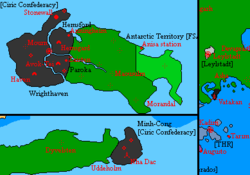
| |||
| Map versions | |||
| Capital | Mourn | ||
| Largest city | Mourn, Stonewall, Avok-Tei | ||
| Official language(s) | Common tongue, Parokan, Minh | ||
| Official religion(s) | Cult Tecnologica | ||
| Demonym | Ciran | ||
| - Adjective | Ciric | ||
| Government | Parliamentary Republic | ||
| - Speaker | Avingar Holstadt | ||
| - Suzerain | Cedric Adsen | ||
| - Legislature | Confederate Parliament | ||
| Establishment | 1455 AN | ||
| Area | |||
| Population | 12,810,513 | ||
| Active population | 3 | ||
| Currency | Zaikir (Ƶ) | ||
| Calendar | |||
| Time zone(s) | |||
| Mains electricity | |||
| Driving side | left | ||
| Track gauge | |||
| National website | |||
| National forum | |||
| National animal | Sea Raven | ||
| National food | Mac Nhen | ||
| National drink | Mead | ||
| National tree | Black Spruce | ||
| Abbreviation | CIR | ||
The Homeland is… a number of things. Some of those things are such that I would consider the confederacy to be the most blessed nation on Micras; others I find to bring me to imagine vividly the downfall of all that the confederacy stands for, starting with whatever horrid sight or experience triggered the imagining itself. However, despite this, it is and will always be my Homeland. Thus, it shall always feature most prominently in my memory.—Edward Coldstone, Cira: A Legacy (1675 AN)
The Ciric Confederation of Wrighthaven, Hemsford, Paroka, and Minh-Cong, more commonly referred to as Cira, is a confederate parliamentary republic on the islands of Sypyr and Hypernostria which is comprised of the constituent governorates of Wrighthaven, Hemsford, Paroka, and Minh-Cong, and also of the independent territories of the Free City of Vatakan, the Kingdom of Lumis, and the Realm of Bryconia. The confederacy, which was united under one flag in 1455 AN, is governed in a system that is thought to be based off of an ancient tribal council system, but has evolved to the modern confederate parliamentary system. The confederacy places high value on scientific progress due to the prevalence of the worship of machinery in the area, which originated with the discovery of mysterious documents in the city of Anningheim in 1222.
Culture
The culture of the confederacy is often the subject of debate amongst Ciric scholars and anthropologists, since the path of most traditions and points of culture are difficult to trace back to any singular tradition of the three constituent tribes which founded the confederacy, due to the Ciric practice of dispensing with unnecessary records. This idea is considered one of the most important embodiments of the national motto: Forget the Past. Remember the Future. This is most often interpreted to be best observed by the extirpation of needless historical records which do not hold relevance. Thus, though the past is not necessarily scorned, it is also not placed upon a pedestal to be misconstrued to the point of myths. Individual names are not considered important information to preserve, and are thus discarded and often lost to the annals of history. Information, however, such as that which leads to the discovery of an important invention, as well as the general course of events, is preserved officially. It is not illegal to preserve pieces of information which are not accepted to be important to the nation, however this is not common because of the general stigma about past specificities. Much of the confederacy's culture today was carried through the ages through word of mouth and other such methods of transmission outside of official vectors.
Most of the larger aspects of the confederacy's culture originate with the 1222 discovery of the Anningheim Documents, which provide a framework not only for Ciric culture but also for the most common Ciric religion, that being the Cult Tecnologica. The specifics of these documents is the most read information in the confederacy, with the documents containing both blueprints, schematics, and formulae which lead to the early scientific leap taken by the confederate constituent tribes in the thirteenth century, but also the philosophies of the writers of the documents, which provide the basis for the Cult Tecnologica. These philosophies lead to a common feeling throughout the confederacy that progress is the most important part of society. Scientists, engineers, and doctors are held in the highest regard throughout the confederacy, solidifying the strata that form the basis of the informal caste system, with administrators at the top, followed by the scientific community, the military, and finally the civilian base. Unlike other caste systems, however, mobility is possible, although not always encouraged. The proper allocation of careers is a high priority in the confederacy, and though an individual's caste occasionally determines the amount of respect given to them, it is still considered important for the confederacy to maintain a skilled base of labourers and managers of services to hold up the higher castes, and thus an individual is considered to be a responsible and respectable confederate citizen if they maintain a service or industrial based career for the good of the whole confederacy.
The tendency to recognise science and progress as the reason for society tends to degrade as one moves further into the countryside, though the grasp of the confederate government and influence of the Cult Tecnologica never fully loses hold or results in isolated villages of paranoid peasantry. Even the most rural of villages enjoy access to the advanced science and technology of the confederacy, though in certain areas supplies of Ferris Fortis are heavily managed in order to conserve the limited amount of the precious metal because of the difficulty in manufacturing the metal in a non-metropolitan setting. Furthermore, civilians in rural areas are just as likely as those in a heavily urbanised environment to espouse socially-liberal or left-leaning principles, especially those which promote cooperation and inclusion. This is because, due to the harsh environment of the antarctic land in which the confederacy is situated, a general acceptance of collectivist theory is common among confederate citizens. It is often that a visitor to more rural areas will hear the confederate adage, If one man has fish, the village starves. Promotion of a strong spirit of community is what brought the development and civilisation of the early Havanite and Fordian tribes in the area.
Minh-Cong differs drastically from the main area of the confederacy on Sypyr, as it had only acceded to the confederacy in the early sixteenth century, having little contact with the tribes that would eventually constitute the confederacy before that point. There does, however, exist a similar spirit of community and acceptance amongst the Minh-Cong, again owing this trait to the harsh conditions of the icy islands. However, most Minh-Cong do not espouse the absolute importance of technology and development that the mainland confederates are so prone to do, instead having a culture dedicated to beauty, both physical and metaphorical. Minh-Cong tends to produce a good number of fine arts practitioners and fewer scientists, and its people rarely adhere to (or attempt to understand) the caste system that is generally accepted by mainland confederates.
It is not impossible that, while walking through the streets of a confederate city, one might encounter a civilised dragon, though it is uncommon. Dragons sparsely inhabit the western portion of Sypyr, and these creatures occasionally produce offspring with a higher level of intelligence than its brethren, which, due to coinciding physical disabilities compared to its kin, cause the intelligent variants of the hatchlings to be abandoned by their migratory families. Occasionally these abandoned young will find their way to Ciric cities and villages. Because of the connotation dragons hold with the society of the mainland confederacy, especially in Hemsford, dragons that appear in villages are almost always diligently cared for by the townsfolk, who tend to believe the dragon was sent as a spiritual blessing. In larger cities, there are often special portions of schools set aside which, in the event of an intelligent dragon appearing in the city, serve to educate the young dragons on society, Ciric history and culture, and the languages of the confederacy, so that they may lead productive lives in society.
While the existence of dragons among society is considered a spiritual (or divine, depending on who you ask) blessing in the confederacy, the existence of feral dragons nearby civilised lands is considered a pest and, on occasion, a matter of serious concern. Dragons, while often depicted in artwork and media as mighty, god-like creatures, rarely pose a threat to specialised task forces of the Ciric armed forces which are sent to deal with the beasts. Nonetheless, the foreign concept of individual strength is generally only observed in the event that a feral dragon is defeated or killed by a single individual. This affords the slayer with a serious amount of respect from most confederates and a specially high amount of praise from the citizens of whichever village they saved from the pest. Many rural villages keep medals and awards of honour on hand to offer in case of a dragon taking up residence in the surrounding land to encourage rowdy youths of the village to take up the challenge so that the problem can be dealt with. Beginning around the start of the seventeenth century, there was a marked uptake in the hunting of feral dragons, especially hatchlings, to sell their scales for profit as luxury materials. In response to this, initiatives have been taken to preserve the population of feral dragons in the confederacy, most notably by planting breeding grounds farther away from societal boundaries to assure the likelihood of a hunter finding the nest remain low. Most of these initiatives have been instigated at the behest of civilised dragons.
Government
The Ciric Confederacy is governed by a system of confederate parliamentary republicanism, with the citizenry of the confederacy voting for a national delegation at the one hundred fifty seat Confederate Parliament, and subsequently voting two heads of government into office from the exiting members of parliament those being the positions of Speaker and Suzerain. Elections are held for the parliament and Speaker once every three years, with a maximum term limit for both of three, while elections for the Suzerain are held once every six years, with a given term limit for the Suzerain of two.
Political parties of any sort are formally banned in Cira; this is because of the founders of the confederacy sharing a common fear that allowing political parties would create a purely partisan government, focused on the acquisition of power rather than the creation of a better confederacy. Politicians in the confederacy nominally run independently without support from a political party, resulting in a wider variety of viewpoints being represented in the candidate lists for elections. However, political parties do exist, if not de jure then de facto, informally and unofficially. That being said, the wider political spectrum representation has the potential to cause issues during wartime because of the slowness of the parliament to implement policies that benefit the war effort. This was resolved with a motion in 1519 AN which expanded the power of the executive branch in wartime by allowing the Suzerain and Speaker to cast votes at parliamentary meetings while the confederacy is at war, their votes counting for forty and twenty-five votes respectively.
This government is supported by a board of staff, who have various responsibilities among the science, military, and civilian divisions of the populace. This split amongst the staff also serves as a reinforcement to the common informal caste sentiment.
| Office | Office Holder | Portfolio |
|---|---|---|
| Suzerain | Cedric Adsen | Head of Government |
| Speaker | Avingar Holstadt | Head of State |
| Exarch | Dou Siang | Chief Ambassador |
| Director of Science | Duncan Singer | President of the Science Directorate |
| Subdirector of Science | Maro Calder | Secretary of the Science Directorate |
| Secretary of Biotech | Irving Haydensen | Oversight of Biotech Research |
| Secretary of Engineering | Arok Tah-Fel | Oversight of Engineering Projects |
| Secretary of Military Science | Gunnar Egilsson | Oversight of Military Research |
| General Quartermaster | Helga Petersdotter | Material and financial oversight |
| Director of the Military | Vangh Tet | President of the Military Directorate |
| Subdirector of the Military | Harold Varner | Secretary of the Military Directorate |
| Prelate of the Air Forces | Einar Haraldsson | Oversight of air operations |
| Prelate of the Land Forces | Eski Tai-Gof | Oversight of land operations |
| Prelate of the Naval Forces | Sang Doc | Oversight of naval operations |
| General Logistics Officer | Phan Lu | Material and financial oversight |
| Director of Civil Services | Alder Braun | President of the Civil Directorate |
| Subdirector of Civil Services | Mors Kao-Barh | Secretary of the Civil Directorate |
| Proctor of Services | Erming Evelstadt |
|
| Proctor of Infrastructure | Ngo Truc |
|
| Proctor of Information | Faast Koldaer |
|
| Proctor of Finances | Pazen Tragh |
|
| Proctor of Civil Safety | Dinh Tien |
|
Education
Education in the confederacy is taken extremely seriously, with children often being educated by parents or guardians in basic principles of mathematics and science before attending primary education. This tradition enables mainland confederate students to enter school at a higher intellectual level than those students of a similar age in foreign countries, and thus the school system is structured to allow for this, teaching children advanced maths and science principles by the time they leave primary education (which, in the confederacy, is 16 years of education from age five to age twenty-two). Secondary education is practically a societal requirement for people who don't already show exemplary intellectual achievement if they want to go into the workforce as service-providing workers, particularly if they want to serve as a scientist, serve in the military, or work as a member of the Cult Tecnologica. Students who wish to go into the workforce in a manufacturing position or an industrial worker are not expected to attend secondary education, but it is still recommended to students due to the lower job security of these careers as a result of the rapid mechanisation of these sectors.
Education in Minh-Cong is significantly different, focusing mainly on arts education rather than science. Minh-Cong students are only expected to attend school until age sixteen; any after that is optional, and usually one must seek secondary education in the mainland confederacy due to the lack of higher-learning institutes in Minh-Cong. Those in the mainland confederacy, likewise, are expected to attend schools in Minh-Cong if they wish to have a career in the fine arts.
Foreign Relations
Foreign relations for the confederacy have been mostly a non-issue for its past existence, mostly due to the people of the confederacy not being an independent country for large parts of its history and working as unified citizens of various other countries which had inhabited the islands of Sypyr and Hypernostria. In recent times though, especially under the leadership of Speaker Avingar Holstadt, the confederacy has taken a more active approach to foreign relations, desirous of positive trading relations with foreign nations, though these plans have yet to be fully enacted; the confederacy has planned to use its production of certain metal alloys which are stronger and lighter than steel and the confederacy's scientific prowess as diplomatic chips to secure favourable relations with various nations.
| Nation | Status | Visa Policy | Notes |
|---|---|---|---|
| No Contact | Visa required | ||
| No Contact | Visa required | ||
| No Contact | Visa required | ||
| No Contact | Visa required | ||
| No Contact | Visa required | ||
| No Contact | Visa required | ||
| No Contact | Visa required | ||
| Ally | Free movement | The Realm of Bryconia is an independent territory of the confederacy and maintains its own diplomatic policies; Bryconia is a member of the Union Australis | |
| Ally | Freedom of Movement | Formed the Union Australis with Caradia 5.XIV.1679; Caradia is offered the protection of the Southern Control Zone | |
| No Contact | Visa required | ||
| No Contact | Visa required | ||
| No Contact | Visa required | ||
| No Contact | Visa required | ||
| No Contact | Visa required | ||
| No Contact | Visa required | ||
| No Contact | Visa required | ||
| No Contact | Visa required | ||
| No Contact | Visa required | ||
| No Contact | Visa required | The Haifo-Pallisican Imperial Trade Union is offered the protection of the Southern Control Zone | |
| No Contact | Visa required | ||
| No Contact | Visa required | ||
| No Contact | Visa required | ||
| No Contact | Visa required | ||
| No Contact | Visa required | Jingdao is offered the protection of the Southern Control Zone | |
| No Contact | Visa required | ||
| No Contact | Visa required | ||
| No Contact | Visa required | ||
| No Contact | Visa required | ||
| No Contact | Visa required | ||
| No Contact | Visa required | ||
| Ally | Free movement | The Kingdom of Lumis is an independent territory of the confederacy and maintains its own diplomatic policies; Lumis is a member of the Union Australis | |
| No Contact | Visa required | Mercury is offered the protection of the Southern Control Zone | |
| No Contact | Visa required | ||
| No Contact | Visa required | ||
| No Contact | Visa required | ||
| No Contact | Visa required | ||
| Friendly | Visa required | Ralgon is offered the protection of the Southern Control Zone; positive diplomatic relationship established; however, tensions exist from the Ralgons due to the existence of the very same control zone, due to perceptions of Ciric attempts at military overreach as well as a breach of freedom of movement between Ralgon allies and its important bases and colonies; presently, Ciric military vessels are not allowed near Ralgon waters | |
| No Contact | Visa required | ||
| No Contact | Visa required | ||
| No Contact | Visa required | ||
| No Contact | Visa required | Sanama is offered the protection of the Southern Control Zone | |
| No Contact | Visa required | ||
| No Contact | Visa required | ||
| No Contact | Visa required | ||
| No Contact | Visa required | ||
| Unfriendly | Travel prohibited | While uncontacted, research on the activities of Stormark conducted by the Speaker revealed the nation to be completely incompatible with the ideology espoused by the confederacy | |
| No Contact | Visa required | ||
| No Contact | Visa required | ||
| No Contact | Visa required | ||
| Ally | Free movement | The Free City of Vatakan is an independent territory of the confederacy and maintains its own diplomatic policies; Vatakan is a member of the Union Australis | |
| No Contact | Visa required | ||
| No Contact | Visa required | ||
| No Contact | Visa required |
Economy & Infrastructure
The economy of the confederacy is, currently, a rather insular one, depending, ironically, primarily on the service sector, including scientific and engineering work. The first sector of raw material production takes up roughly seven percent of jobs, making up for the low import rate by utilising highly mechanised workforces in these environments; a perfect example of that is the Confederate Farmer's Union, which is the conglomerate of most of the large mass-producing farms in the confederacy, which produces over eighty percent of its produce underground in specially designed maximum-efficiency farms and hydroponics labs, using automatic water and fertilising systems to reduce the amount of labourers needed. The second sector utilises a similar tactic to reduce the amount of work needed, since, as most second sector jobs are manufacturing jobs involved with assembly line production, mechanisation is very easily to implement with these jobs. As such, most confederate citizens tend toward service-sector jobs, primarily in science and engineering.
The road system of the confederacy is modernised to a degree of reduction; the amount of feral dragons and raiders from uncivilised lands is rather high in the unsettled regions in between cities, and as such a system of high-speed magnetic trains is implemented to facilitate travel and transport between urban centres. These trains are supplemented by the confederate power network, which is split between an old system of nuclear reactors which are slowly being replaced by a new system of fusion reactors, starting in the capital of Mourn. This power system allows the confederacy to produce a high amount of power with low waste and low input materials, due to the high-energy nature of fusion reactors.
The corporate environment of the confederacy is entirely hostile to foreign influence, because of the far-reaching presence of the Andromeda Tech Corporation, which is the largest company in the confederacy. While the company found its roots as a tech company, as its name suggests, it has become a holding company in recent years, doing almost all of its work through its many subsidiaries. Andromeda Tech is highly aggressive in its tactics of reducing foreign influence on the economy of the confederacy, mainly through providing a large, easy-access brand that focuses on the same industry as any foreign company that it perceives as a threat. The Andromeda Tech Corporation is not nearly as unfriendly to domestic small companies, often partnering with some of the ones that have reach throughout the confederacy, and doing their utmost to avoid bankrupting local businesses in rural towns, though it is sometimes unavoidable without entirely refraining from allowing these rural businesses interaction with the corporation. For these reasons, the corporation has thus-far kept itself from expanding into the realm of resource-acquisitions, preferring instead to allow smaller businesses access to this, though the corporation has also stated that it has plans in place to secure the market should any foreign company attempt to dominate that sector.
Religion
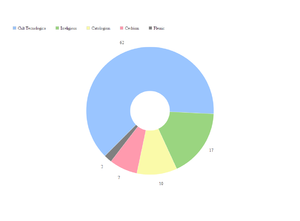
Being that one of the prime institutions of confederate law is the idea of freedom of religion, religion in the confederacy is not so narrowly focused on one or two religions, though one particular religion, the Cult Tecnologica, which was founded in the confederacy and based off of the ideas and principles of the Anninghiem Documents, does hold a majority following in the confederacy. The confederacy is also known to have a large percentage of irreligious citizens who, whether deist, agnostic, atheistic, or else wise, do not express a specific religion that they follow. The confederacy has also picked up other religions from more far-flung places in relation to the islands in which the confederacy is situated during the periods of occupation which took up portions of the past history of the islands; only three foreign religions have been measured to have a following in the confederacy worthy of any significance: Catologism, Cedrism, and the Church of the Black Flame, though the latter's caustic and xenophobic nature has prevented the spread of the religion very far outside of the few Caradian immigrants that live in the confederacy. It should be noted that most of the irreligious population lives in Minh-Cong, which is an outlier in terms of religion and culture; though not all are members of the Cult Tecnologica, most mainland confederates are religious to some degree.
The Cult Tecnologica, which is the primary religion of most confederate citizens, is run completely separate from the state, though it and the state of the confederacy have cooperated on various occasions in the past, due to the cult's large humanitarian volunteer base. The cult does not maintain an active ecclesiarchy, and it does not have a great many churches or temples. The cult's primary leader in ecclesiastical matters, the magister prime, is elected every four years by a majority vote open to all cult members. The cult is also lead by two others, who manage much of the real work that the cult does, these being the prime machinist and prime hospitaller, who run the operations the cult conducts regarding invention and health services, respectively.
The cult's main philosophy is similar to the philosophy of the confederacy itself; that being the idea that progress itself is sacred and invention and science are the paths to enlightenment. However, though the cult organises itself more like an association of philosophical beliefs rather than a true religion, it does make vague or open to interpretation claims on divinity and higher powers. The cult's main assertion regarding the divine is that the creator of the world, who is referred to either as the First Machinist or the Prime Being, created the sapient inhabitants of the planet Micras to reconstruct its form should it be destroyed. As such, the Cult Tecnologica believes that innovation, technology, and knowledge are manifestations of the divinity of the First Machinist, and that the responsibility of the cult and sapient creatures as a whole is to continue the march of innovation and progress in order to discover a way to reconstruct the First Machinist. This focus on innovation is what causes the cult to disavow strong ecclesiastical leadership, as it espouses that the individual's creative ability is restricted when it is more tightly controlled by a religious order.
Defence
The confederacy takes the defence and protection of its citizens, territory, and interests very seriously, with this protection being one of the highest priority government directives in the confederacy. The main method the confederate government uses to assure this protection is the Confederate Defence Grid, which is used to protect against malevolent forces originating outside of the confederacy, though there are other avenues taken to assure the defence of the confederacy's civilian population, including the Confederate Guard, which functions as a national guard force, serving under the Confederate Army, and the Moros Corps, which is the police force of the confederacy, which patrols confederate cities with its police officers, called Moros Functionaries, to prevent crime and internal damage.
Constituent Territories
The Ciric Confederacy is composed of a number of special territories, which are subject to the overall will of the confederacy but have certain independent priviliges. The confederacy consists of four governorates, which are full members of the confederacy and possess a medium degree of autonomy, three independent territories, which are far more independent, and one special municipal zone.
| Flag | Constituency | Capital | Leader |
|---|---|---|---|
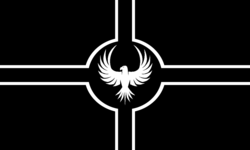 |
Hemsford | Hemsgard | Erik Vagnsen |
 |
Minh-Cong | Nha Dac | Rhan Nuyen |
 |
Paroka | Avok-Tei | Marlav Los-Tel |
 |
Wrighthaven | Haven | Hailey Brauns |
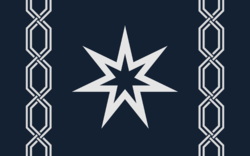 |
Bryconia | Deeprift | Guy Martin |
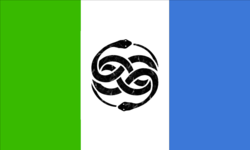 |
Lumis | Witzenbourg | Wilhelm vän Holsetz-Liebenbach |
 |
Vatakan | Vatakan | Witold Karków |
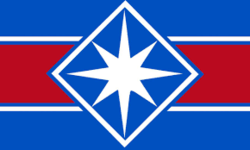 |
Mourn | Mourn | Charles Banwick |

